Don’t blink, or WCHA standings shift dramatically
By John Gilbert
The WCHA race is like a staring contest. Don’t blink and you move up, maybe to first place; but blink, and you realize it’s much easier to lose ground than to gain it.
The league race is in a knot, tied tighter because of January weekend splits. The University of Minnesota-Duluth beat Wisconsin 2-0 in Amsoil Arena, while Minnesota stung North Dakota 3-2 in Grand Forks, and Denver was fit to be tied 4-4 in Mankato, and Nebraska-Omaha couldn’t solve fellow-newcomer Bemidji State, tying 2-2 in Omaha. UMD’s victory pushed the Bulldogs past North Dakota and into first place in the WCHA, while Denver and Nebraska-Omaha gained only a point with their ties but stayed close behind.
One night later, UMD fell behind 3-0 in a game that was more of a penalty-killing demonstration, and even a furious finish left the Bulldogs on the short end of a 3-2 score. The loss rudely knocked UMD (10-4-2) from first place to third, behind North Dakota (12-4), which bounced back to whip Minnesota 4-1. Denver (10-3-3), came off its first-game tie to rally from behind and subdue Minnesota State-Mankato 4-3 in overtime, lifting the Pioneers to second. Nebraska-Omaha (9-5-2), meanwhile, was stung 3-2 in overtime by Bemidji State, holding fourth. UNO is probably happy to be done with Bemidji State; while the Beavers are 5-9-2 in their first year in the WCHA, they are 3-0-1 against Nebraska-Omaha, having won 3-0 and 3-1 earlier in Bemidji before the 2-2, 3-2 series at Omaha.
There is no indication the WCHA will loosen up anytime soon, although the top four seem to have an edge. After North Dakota, Denver, UMD, and Nebraska-Omaha, the league breaks into a tight cluster at .500, with Minnesota (7-7-2), Wisconsin (7-7-2) and Colorado College (8-8) all tied. Any of those three could move up to contention, or, they could just remain be in for a wild and entertaining ride as all three try to fit into two slots that would give them home ice for the playoffs.
Colorado College got on a hot streak just before the holidays and rose from the depths to the battle for middle ground. But CC was startled last weekend, losing 4-1, 2-1 at Alaska-Anchorage, which moves the Seawolves (6-8-2) into a challenging eighth place. Minnesota has always had the capability, but for various reasons hasn’t been able to put together enough consistency for a hot streak. The Gophers played their best two games of the season against UMD, then, in their own tournament, they were beaten by Union and tied by Ferris State. They returned to the form they had displayed against UMD to beat North Dakota the first night, but couldn’t sustain it against the tenacious Fighting Sioux in the rematch.
Wisconsin, rebuilding after losing heavily to graduation and pro signings, has also risen on a hot streak, winning seven straight games coming into Duluth. The Bulldogs used a familiar tactic to win the opener 2-0. That tactic has been explosive scoring from a first line with Jack Connolly centering Mike Connolly and Justin Fontaine, and a dazzling power play, featuring the quick puck movement of that top line. Against Wisconsin, Fontaine and Mike Connolly scored first-period power-play goals. The difference was that coach Scott Sandelin juggled his lines, moving David Grun up to the line with the Connollys, while Fontaine moved to apply his scoring touch on Travis Oleksuk’s wing.
Fontaine rejoins his former linemates on the first power-play unit, and that’s what came through against the Badgers. Thirteen minutes into a scoreless first period, UMD got its first power play. Jack Connelly made a very slick behind the back pass to Mike Connelly, who fed behind the net to Grun, for a quick relay out front that found Fontaine for a quick shot and a 1-0 lead. A couple minutes later, another Wisconsin penalty created the scenario, and Mike Connolly scored from the scramble in the slot to make it 2-0. UMD’s first two goals in the new Amsoil Arena led to the first Bulldog victory there as well.
Kenny Reiter got the shutout, continuing his hot hand. When the Bulldogs snatched a pair of overtime victories from Wisconsin in Madison during the first half, Reiter was shelled at the start of the first game, and freshman Aaron Crandall — once a Badger recruit — came in and starred to gain the sweep. But Sandelin prefers to go with the hotter goalie, and Reiter showed he had regained his form in the first game to pay dividends on the strategy, and to pay back the Badgers.
The next night, however, Reiter was more the victim than the problem, as seven of the first 10 penalties in the first two periods were awarded to UMD — including two 5-minute majors — giving the Badgers both opportunities and momentum. Craig Smith, Wisconsin’s ace centerman, made a strong rush 2-on-2, cutting to his left and skirting both UMD defensemen before virtually handing off the puck to his left, where Sean Dolan skated by, cut back to the net and scored at 6:39. UMD killed off the next penalty, but just 10 seconds after it expired Podge Turnbull snapped a shot from the left side past Reiter for a 2-0 lead at 11:50.
Justin Faulk was given a 5-minute major and ejected for a checking from behind call at 19:35, and Smith got open at the top of the left circle and rifled a shot into the left edge on the carryover power play at 0:55 of the second period. The Bulldogs, who were outshot 16-5 in the first period, came back to generate some chances in the second, although when the red light flashed after Jack Connolly’s blast from the left side at 6:20, the officials reviewed it and disallowed the shot for glancing off the far pipe. The officials were far more of an obstacle later in the evenly played middle period, however.
After an exchange of penalties, Mike Connelly threw a check on the end boards, and it was ruled that he made “contact to the head,” so he was given a 5-minute major and tossed at 14:19. Losing their second key regular for the game hurt, to say nothing of losing one of their prime offensive catalysts, but Joe Basaraba was called for a cross-check at 16:32, and Jack Connolly — the other half of the Connolly offensive spark duo — was called for hooking at 17:12. That left the Bulldogs two men short for four solid minutes, but the penalty killers and Reiter did an amazing job to hold the deficit to 3-0.
The third period was a valiant attempt to let the Badgers catch up on penalty-box time, as five of six penalties went to the guys in red, one of them a 5-minute major when Mark Zengerle got a contact-to-the-head call at 10:10. UMD’s power play put on a lot of pressure, but didn’t score, and didn’t penetrate for many good chances except for a couple more pipe shots, and the game went into its final two minutes, still 3-0. Another UMD power play failed to connect until the secondary unit came out. Seldom used freshman Max Tardy was deep on the left and sent a hard centering pass to the crease where the puck deflected in off Basaraba’s skate with 1:59 left.
Down 3-1, it didn’t look much better to the 6,668 fans, but Reiter was pulled for a sixth attacker with 1:50 remaining, and UMD’s best pressure of the game gave Oleksuk the chance to score with 25 seconds remaining. After a couple more chances just missed, UMD had to settle for a 3-2 loss and a split of the series. After being outshot 26-16 through two periods, UMD held Wisconsin to no shots — as in zero — in the third period. Obviously, that’s at least a tie for the team record, set May 19, 1970, when Wisconsin’s Cinderella team lost 2-1 to Cornell in the NCAA semifinals.
UMD couldn’t be dispirited by the split, considering the closing rally fell just short, despite losing Faulk and Connolly, and yielding only one goal while killing two majors and four minors. Problem is, the standings don’t give credit to close calls and valiant comebacks, and the Bulldogs need to realize that as they hit the road for Houghton, Mich., to face a Tech team that has struggled mightily. But when they last met, Tech led 2-0 at the DECC and UMD needed a 4-goal third period to win 5-3.
AMSOIL ARENA ADJUSTS
First impressions at Amsoil Arena showed a few little nitpicks, despite the gushing flow of accolades for the beautiful new facility when UMD opened against North Dakota. When Wisconsin came to town for the second UMD game at Amsoil, several subtle adjustments had been made to improve those little things. For one, it was pointed out here that the very good UMD band was stuck down at ice level, where their sound was focused on the backside of the glass boards. Last weekend the band was elevated to concourse level of the end section, where all of that inspirational music was much more effective.
The big scoreboard has been changed to feature the score and pertinent information on both edges, simply by reducing the ongoing game video slightly to fit inside the borders. Also, the disc-shaped statistical board under the video board has been redone, reducing the center area where the period number is shown and giving more space to either side, where the team, its score, shots on goal, and any penalties can all fit. They still need to find a way to leave some semblance of the score and remaining time when the scoreboard switches to become all artsy-craftsy between periods or during time-outs or penalty stops, because the two auxiliary scoreboards remain impossible to see on the press-box side of the arena.
Next up for Amsoil Arena is the UMD women’s team coming home, battered and in need of a couple of huge performances against Wisconsin Friday and Saturday nights. The Gophers took over a month off for holiday time, while other teams returned to play for a weekend. So when UMD returned to action at Minnesota last weekend, the Gophers tied the Bulldogs and beat them in a shootout, then beat them again Saturday to vault over UMD and into second place, behind Wisconsin.
For most of the first half, the Women’s WCHA was a two-team race between Wisconsin and UMD. Maybe taking so much time off was part of the problem, but it was made worse by the schedule — coming in cold, out of the cold, to play at Minnesota and then Wisconsin has pretty well eliminated UMD from title contention, and may prove to leave the Bulldogs trying to regain their form from third place.
Duluth East topples No. 1 Eden Prairie in Amsoil debut

Duluth East junior Dom Toninato (19) watched his overtime deflection reach the goal an instant before diving Eden Prairie goalie Andrew Ford.
By John Gilbert
It’s not how long you have the puck, it’s where it goes after you no longer have it. That could be the new motto for Duluth East center Dom Toninato. It didn’t matter that the No. 3 Greyhounds were badly outshot, and mostly outplayed by No. 1 ranked Eden Prairie on a Saturday afternoon in January at Amsoil Arena. What mattered most was that Toninato scored two goals that took less than a blink of an eye — the second in sudden-death overtime — to give East a 4-3 triumph.
While claiming their biggest victory of the season, in the first high school game played at the new arena, the Greyhounds had to hold their poise as the flow of play and the shot-chart compiled evidence against them. Eden Prairie outshot East 12-3 in the first period, and 32-14 for the game. But JoJo Jeanetta was at his best in goal to hold the ‘Hounds within reach through regulation, and Toninato, who found just the right touch for East’s first goal, scored again on a deflection that took its tantalizingly slow time before crossing the goal line at 0:52 of overtime. If it was possible to add up the elapsed time the puck was in contact with Toninato’s stickblade for both goals it would define the word millisecond.
“It was just what we expected, coming up here,” said Eden Prairie coach Lee Smith. “We knew East would be tough and we expected a great game.”
But he couldn’t have expected the way the result was fabricated. East was trailing 1-0 and had been outshot 9-1 at 12:56 of the first period when Toninato cruised past the crease left-to-right just in time to deflect in a crisp power-play centering pass from Jake Randolph, near the right corner. Time of possession? Whatever it takes for a one-touch ricochet. That came on East’s first power play of the game, for a 1-1 equalizer. A lot happened before East needed to call on its slick power play again. East was outshot in the second period, 10-6, but gained a 2-1 lead when Zac Schendel scored with a rebound from wide to the left of the cage late in the period,
Eden Prairie’s Kyle Rau did his best to ruin Jeanetta’s big day in the third period. The skilled and quick centerman, who is committed to Minnesota, scored goals at 1:22 and 14:09 of the third, the first to gain a 2-2 tie. Hunter Bergerson’s goal from left point regained the lead for East two minutes later, but Rau struck again with three minutes left to tie it 3-3. That was hard-earned against Jeanetta, but hardly a suitable reward for the Eagles, who had outshot East 32-13 through three periods.
An Eden Prairie penalty with 25 seconds left in the third period carried over into overtime. Again, the power play clicked. Toninato went to the front of the net, and again the quick-passing Greyhounds worked the puck around until Meirs Moore cut loose with a shot from the left point. Toninato, facing the left boards, saw the shot coming on a trajectory headed just behind him. He reached back, getting his stick on the shot and redirecting it toward the goal — but slowly.
Fortunately for East, Eden Prairie goalie Andrew Ford was screened on the original shot, and didn’t spot the slowly sliding puck until it was slithering through the crease. He made a desperation dive across the crease for it, but was an instant too late. The puck barely crossed the goal line, and Toninato’s instantaneous touch had redirected the puck for a goal.
“They’re the best team we’ve seen, without a doubt,” said Toninato, the junior center on East’s most productive top line. “They did a good job of clearing rebounds and keeping us from getting many chances. But our power play is working at something like 40 percent. On the overtime goal, I was facing to the side and I had to reach back for the puck.”
But all he had to do was touch it, which took about the same amount of time as his first-goal deflection. But the state ratings don’t require any minimum time length for the puck to be on a goal-scorer’s stick.
“This should bump us right up there,” said Toninato, whose dad, Jim Toninato, came down from International Falls to play for UMD back in the Brett Hull glory years of the mid-1980s. Maybe good hands are hereditary.
East had only lost twice to that point, a 2-1 opening game overtime loss at Wayzata, and a 4-3 loss against Edina in the Schwan’s Cup holiday tournament. In that Edina game, East was outshot 10-3 in the first period and trailed 1-0 — sound familiar?– but rallied from a 3-1 deficit to gain a late 3-3 tie before Edina won it. Against Eden Prairie, being outshot 12-3 was another in a continuing series of lessons about the necessity to start games at full-throttle.
East’s success includes a tough 2-1 victory over Grand Rapids earlier last week, as the Thunderhawks are proving that there is another strong Class AA team Up North. You could toss Eden Paririe, Edina, Hill-Murray, East, and Wayzata into a hat and pick one as the state’s No. 1 team. And late-blooming Moorhead, Apple Valley and Grand Rapids are not far behind. Meanwhile, Hermantown keeps on rolling in Class A, and remains the state’s only unbeaten team in either class, while being ranked No. 2 behind St. Thomas Academy. As usual, when Heremantown coach Bruce Plante rebuilds, he really just reloads.
Evolution MR evolves into car for all seasons
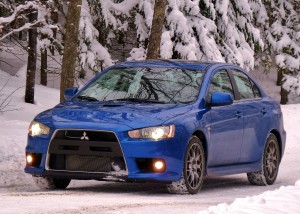
Snow-laden trees and icy roads were no match for the Mitsubishi Evolution MR -- with the right tires.
By John Gilbert
Wintertime can be a great equalizer. Especially when it’s extreme, like the winter of 2010-2011, which is setting records all across the Upper Midwest for snowfall and cold temperatures. But after all, what else is there to extreme winter but snow and cold? In the automotive world, virtually every car produced has enough good features to impress most people, but a lot of cars come up startlingly short when asked to perform in the worst winter conditions.
Then there is the Mitsubishi Evolution MR. The Evolution is a basic Lancer compact that has been thoroughly upgraded for high performance in every way, starting with a sizzling hot turbocharged engine and adding high-end components, improved beyond reasonable limits, to make sure all the parts can keep up with the performance generated by that engine.
When I first heard I was going to get a 2011 Evolution for a week between Christmas 2010 and New Year’s 2011, I was concerned about its driveability in that particular week, because Minnesota had been blanketed with a 10-inch snowfall on top of a sleet-formed ice base. I knew the Evolution has all-wheel drive, and I knew it is one of the most spectacular cars to drive on dry pavement, but I wondered if the all-wheel drive would simply mean all four wheels would spin rapidly while the car stayed in the same place.
My worries were put to rest immediately. The car was delivered wearing Dunlop Wintersport SP tires, instead of the summer high-performance rubber. To my great surprise, the car with those tires stuck on snowy and icy roads almost as impressively as the sticky summer performance tires make it stick to a road or racetrack. Read more
Smaller cars pace Detroit Auto Show reality check
By John Gilbert
DETROIT, MICH. — For the last couple of years, a grey cloud of doubt and pessimism provided the undercurrent at the North American Auto Show. But when the 2011 show kicked off with two media preview days on January 10-11, all was positive and uplifting by comparison. That hardly means the traditional domestic Big Three of Ford, General Motors and Chrysler are on secure footing, but it does mean they seem to be on the right track for returning to respectability and, more important, profitability.
So eager are members of the automotive media to help out with the respect for the “home” teams, 49 North American media types kicked off the “Go Detroit” theme by naming the Chevrolet Volt the 2011 North American Car of the Year, and the Ford Explorer the Truck of the Year. The decided leaning toward domestic nameplates among the journalist jury of independent voters showed the plug-in electric Volt collected 233 points, to 163 for the runner-up Hyundai Sonata, and 94 for the pure-electric plug-in Nissan Leaf. Explorer’s margin among truck finalists was larger, with 253 points to 138 for the runner-up Jeep Grand Cherokee, and 99 for the Dodge Durango in a battle among three domestics.
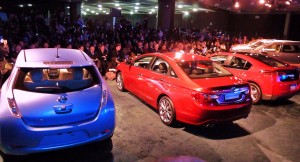
Electric Nissan Leaf, left, Hyundai Sonata, winning Chevrolet Volt awaited Car of the Year decision.
The awards all have significant merit, although they also show that the manufacturers might have come farther from the “good old days” than the media, in getting past two major hurdles — expensive vehicles, and large SUVs. In the industry, consumer demands have caused every manufacturer to strive to build more fuel-efficient vehicles costing under $25,000, and the same manufacturers have accepted the public avoidance of large, truck-based SUVs and are building compact crossover SUVs so fast they are one of the largest segments in automotives. The media voters, however, chose the Volt’s electric-with-gas-engine-backup technology, even though it costs over $40,000 and is not yet available throughout the country, over the Sonata, which has a South Korean name but is designed and built entirely in the U.S., costing about half the Volt’s price tag.
The same held in trucks, where the Explorer has been redesigned as a unibody SUV, expanded to three-row length, and it beat out Ford’s own revised and maybe more-popular Edge crossover to gain finalist stature from the jury, along with the reincarnated unibody Durango, meaning two of the three finalists were elongated three-row vehicles, while consumers have emphatically made compact two-row-seating crossovers — including the runner-up Grand Cherokee — the top-sellers in the segment. Read more
Fighting Sioux alter tradition in race to WCHA lead
By John Gilbert
No more smoke and mirrors this season for the University of North Dakota hockey team. That is to say, no more mirrors. Just smoke. You could say the Fighting Sioux spent coach Dave Hakstol’s first six years reflecting on mirror-image scenarios, struggling to the Christmas break each season and then rising to become a solid contendere during repeated second-half surges. But that illusion has been shattered this season, leaving only the smoke from being red-hot through the first half.
The Sioux have raced to lead the WCHA at 11-3 at its midpoint. Kicking off the second half with an exhibition, they cruised into Duluth and christened Minnesota-Duluth’s new Amsoil Arena with a 5-0 romp over the previously No. 1 Bulldogs, leaving the Sioux 14-5-2 overall in the most impressive first half of Hakstol’s seven-year tenure. What can happen in the second half is an imposing thought to the rest of the WCHA.
“This team is no different from any other we’ve had,” said Hakstol. “We’ve been playing good hockey. We work hard, and we’ve gotten through some lineup issues. But we’re no different than in past years.”
That similarity might be called the family plan, because that’s what all of Hakstol’s teams have had in common. Totally unified, their unselfish play and teamwork is something that every team would like to have, vows to have, or pretends to have. North Dakota has it, and sets standards for team cohesiveness that other teams strive for.
This team is clearly different when it comes to results, however. In Hakstol’s previous years, North Dakota has had impressive talent, led by some big-gun scorers. Yet all of those teams struggled enough with injuries or inconsistent play through the first half of their seasons that the Sioux were jokingly accused of purposely laying low so they’d be fresh enough to respond when Hakstol would fire-up the charge from middle-of-the-pack chasing the title. That formula worked for Hakstol’s first four teams, all of which reached the Frozen Four. His fifth team won the WCHA league title, while last year’s Sioux came together to win the Broadmoor Trophy for its second championship at the Final Five playoffs.
This season, however, there are two major differences. The first is the impressive first-half success. The second is that this team, ironically, has no Zach Parise, T.J. Oshie, or Jonathan Toews — the super-scorers who led the Sioux in recent years before signing NHL contracts and departing early. Instead, the Sioux have used surprising balance.
“It’s true, we don’t have the big-name scorers this year,” Hakstol acknowledged. “But we’ve got enough guys who feel like they should score, and like they should contribute, so they do.”
The 5-0 victory at Duluth was a perfect example. A sellout crowd of 6,732 filled Amsoil Arena, and the UMD Bulldogs attacked with their favorite hard-forechecking, quick-passing style, cycling off the end boards for repeated good chances. But North Dakota played superb team defense in front of goaltender Aaron Dell, a sophomore who has displaced returning star Brad Eidsness. With considerable poise, the Sioux prevented the pesky Bulldogs from getting clean chances from the slot, or repeated chances in front.
Four different players got goals, but it was a 1-0 game until a strange circumstance in the second period. A broken pane of tempered glass in the side boards shattered with 6:25 left in the first, so the teams broke for intermission early. The final 6:25 of the period was then played, followed by the horn, a change of ends, and then the 20-minute second period. It almost seemed as though UMD was groomed for 20 minutes, but had trouble playing 26:25. After matching the Sioux chance for chance at 1-0 for 17:19 of the second period — or an actual 23:44 with the extra 6:25 — the Sioux erupted for three goals in the span of 1:14 to take command at 4-0.
Brad Malone scored two goals, one in the first period and one in the third, while Carter Rowner, Danny Kristo and Matt Frattin got one apiece in the second-period flurry. Evan Trupp set up Frattin’s goal, and Trupp also fed Malone for his second goal, shorthanded in the third. Frattin, a senior winger, has 18 goals to lead the WCHA in all-game goals. But much of the Sioux success has been ignited by the unselfish play of Trupp. Hakstol, who would rather not single out individuals for superlatives, appreciates such contributions.
“Evan has been, arguably…” said Hakstol, groping a bit to avoid overdoing it, altering the second part of the compliment. “He’s been extremely reliable.”
As for the goaltending, Hakstol said the 5-0 victory wouldn’t have been possible without Dell. “We didn’t have a lot going on the first 10 minutes,” said Hakstol. “UMD’s first line cycled the puck and gave us trouble the first 10 minutes, and they had a lot of chances to tie the game when it was 1-0. Some of the bigger plays we made were by Aaron Dell.”
It took 35 saves to blank the Bulldogs, and Dell stopped them all. “He’s given us a chance to win every time he’s played,” Hakstol said. But he stopped short of saying Dell was No. 1. Eidsness, a returning standout as a junior, was a key reason why North Dakota was the consensus preseason pick to win the WCHA. But Dell, a sophomore, has taken the No. 1 slot and stands 13-4-1 while Eidsness is 1-1-1. In 17 games, Dell’s 2.20 goals-against average and a .910 save percentage are among the league leaders.
“We’re definitely not a one-goaltender team,” added Hakstol.
Nobody typifies North Dakota’s family plan better than Chay Genoway, the 5-foot-9 dynamo on defense. Genoway went from dynamic team catalyst to the sidelines when he suffered a concussion after being checked from behind into the end boards last season. He never lost consciousness, but the concussion’s lasting effect was a never-ending string of severe headaches, every day. It was bad enough that it precluded his return to the lineup, and also prevented him from going to class. He was granted a medical redshirt to come back for a full senior season, but even then his status was uncertain, because he couldn’t work out until midsummer. Once back on skates, his return to form was a long, slow process.
“Whenever I’ve been hurt, I’ve always worked harder and harder to get back into the lineup,” said Genoway. “But with this, the less I did the better it was. At the start of the season, the game was too quick for me. Finally, it’s slowing down.”
Ironic that the player the rest of the WCHA has had trouble catching up to had become a player who had to catch up to the pace of the game. It took great determination on Genoway’s part. Hakstol was more than willing to be extra-patient with his prize defenseman, who was voted the preseason player of the year last season.
“It was an issue with our team to get Chay back,” said Hakstol. “It’s taken nearly a full two months for him to get back to form, but now he’s a toughened version of what he was last year, and it was a big boost to the team immediately when he came back. I’d say he’s nearly 100 percent now, but the best thing is, he’s going to get better and better over the next three months.”
The next three months, on top of the first three months, would put North Dakota right there in prime position for playoffs.



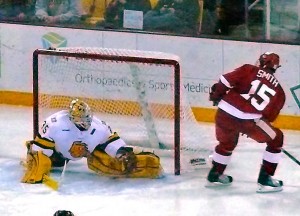
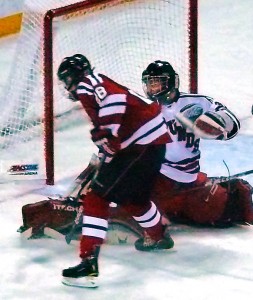

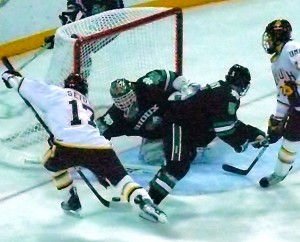
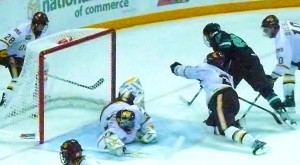

 John Gilbert is a lifetime Minnesotan and career journalist, specializing in cars and sports during and since spending 30 years at the Minneapolis Tribune, now the Star Tribune. More recently, he has continued translating the high-tech world of autos and sharing his passionate insights as a freelance writer/photographer/broadcaster. A member of the prestigious North American Car and Truck of the Year jury since 1993. John can be heard Monday-Friday from 9-11am on 610 KDAL(www.kdal610.com) on the "John Gilbert Show," and writes a column in the Duluth Reader.
John Gilbert is a lifetime Minnesotan and career journalist, specializing in cars and sports during and since spending 30 years at the Minneapolis Tribune, now the Star Tribune. More recently, he has continued translating the high-tech world of autos and sharing his passionate insights as a freelance writer/photographer/broadcaster. A member of the prestigious North American Car and Truck of the Year jury since 1993. John can be heard Monday-Friday from 9-11am on 610 KDAL(www.kdal610.com) on the "John Gilbert Show," and writes a column in the Duluth Reader.